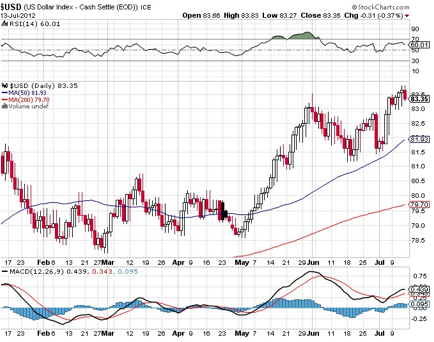 $ INDEX [DXY/$USD]: As noted in last week's column, the breakout point for DXY was above 83.50 which it pierced through rather convincingly on July 6.
$ INDEX [DXY/$USD]: As noted in last week's column, the breakout point for DXY was above 83.50 which it pierced through rather convincingly on July 6.
The 83 level now becomes the new base for DXY. The $ turned down from just a few pips below 84 and should come down to retest the new base 83 in the next week.
On a more long-term time frame, the dollar's first major overhead resistance lies at 85.50 and the new floor at 83. We can therefore expect the $ to reach for higher levels after thoroughly testing the new floor at 83. DXY will remain a buy at all major dips unless 83 is taken out, which is highly unlikely. Remain bullish on the dollar.
Gold [GCQ2 & GLD SPDR]: Gold is approaching an interesting point on the charts where the market will have to reveal its hand in one of several ways. So far, gold has sailed through a fairly orderly correction from its all time high of $1920 without tipping its long-term intentions. The correction so far could be just a normal pause in the long-term bull market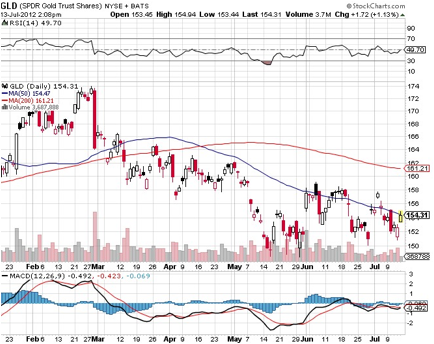 or it could be the beginning of a long-term bear market. We do not know as yet. But the clues should start coming in over the next few weeks.
or it could be the beginning of a long-term bear market. We do not know as yet. But the clues should start coming in over the next few weeks.
The critical level on the downside is $1515. A breach of this level will signal a long-term bear market. This level corresponds to $148 on the GLD SPDR chart above. On the other hand, gold could bounce from the $1550 region to test the downward sloping line through points 1920 and 1790 on the GCQ2 chart.
The odds favour a long-bear market but with a bounce from the $1550 region to somewhere between the $1680 and $1700 region in the intermediate term. A pullback above $1630 will be the first indicator that such a bounce is in the making.
Consider staying out of the gold market for a while. The price compression between $1550 and $1630 presages violent moves either way, which is not worth tracking considering the risk. I would rather wait for a breakout on the downside or for higher level of $1680 to $1700 to sell. Long term, remain bearish on gold.
For now the probability of the tradable rally that I mentioned last week remains very low.
 WTI Crude [CLQ2]: As mentioned earlier, I favour a wave count for crude that holds the current bearish trend as a correction to the move up from $32 in December 2008 to $115 high in April 2011. If that count were true, time-wise the correction in crude should end by the end of July [earliest] or by end of November 2012 [latest]. Between these two dates I favour the earlier date.
WTI Crude [CLQ2]: As mentioned earlier, I favour a wave count for crude that holds the current bearish trend as a correction to the move up from $32 in December 2008 to $115 high in April 2011. If that count were true, time-wise the correction in crude should end by the end of July [earliest] or by end of November 2012 [latest]. Between these two dates I favour the earlier date.
In other words, while I don't rule out a further phase of consolidation, for all practical purposes crude is unlikely to breach its floor at $75. So crude becomes a buy at all dips.
$90 on the charts remains the critical breakout point for WTI crude. We are currently positioned at $87.07. I expect a few more weeks of consolidation between $80 and $90 before a breakout to the topside.
Euro$ [EURUSD & FXE]: By breaking below 1.26 on June 28, 2012, the euro$ confirmed a full five-wave impulse move down whose ultimate target could be 0.95, or near parity with the $.
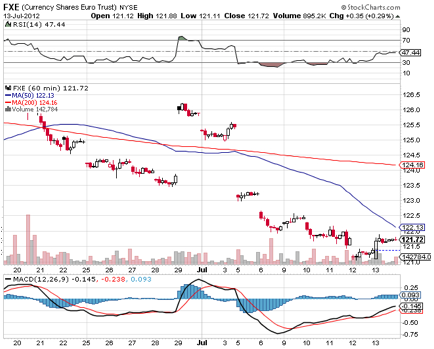 In the near term, having made a low 1.22, the euro could rally back to 1.24 to test its overhead resistance. Its first logical to the downside is now 1.19. Sell euro at every rally.
In the near term, having made a low 1.22, the euro could rally back to 1.24 to test its overhead resistance. Its first logical to the downside is now 1.19. Sell euro at every rally.
India needs to be very wary of the euro moves to the downside. RBI must realise that the move down by the euro is a strategic move by EU in connivance, if not tacit support, from the United States to shift the burden of adjustment in world trade and job cuts to China and India. We must avoid allowing the rupee to rise along with the value of the $ against the euro. Else we will place our entire software services industry in jeopardy. People in India have no idea how lean, mean and hungry the East Europeans are and how rapidly they are picking up proficiency in English.
$-INR: Quite clearly, the $ is in a short-term correction from its recent top of 57.30. Next week, the correction could continue 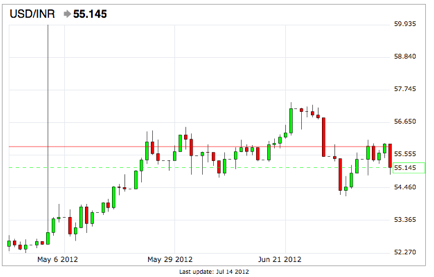 and retest the low of 54.20 made on July 3 which incidentally was the previous top for $ for very many years. So its repeated testing should come as no surprise. Unless the floor of 54.20 is decisively violated, the $ can only move up against the rupee.
and retest the low of 54.20 made on July 3 which incidentally was the previous top for $ for very many years. So its repeated testing should come as no surprise. Unless the floor of 54.20 is decisively violated, the $ can only move up against the rupee.
In a longer time frame we are possibly in wave 4 of 5 for the $ against the rupee that ends middle of August. This could see the rupee dip as low as 53.50. What will follow then is wave five of five. One possible target on the upside is 60.50. Although small, the probability of the rise being capped at 57.50 exists.
Given RBI's trading restrictions, one may not see a full display of the awesome power of a wave five of five. Keep fingers crossed.
S&P 500 [SPX]: SPX continues in its deceptive ways, showing strength where one expects weakness. The trick is to see through the deception.
 There are several ways to do the wave counts for the correction here. The point to note is that point 1374 on July 3 can be seen as a wave four top of which sub-wave two was the rally we saw last Friday. Clearly the pullback is reactive and should be followed by another leg or two down. The logical down target remains 1260.
There are several ways to do the wave counts for the correction here. The point to note is that point 1374 on July 3 can be seen as a wave four top of which sub-wave two was the rally we saw last Friday. Clearly the pullback is reactive and should be followed by another leg or two down. The logical down target remains 1260.
The clincher as far as US equity markets are concerned will come in the strength of the rally that follows after the current down move exhausts itself. It is only then we will be able to more or less confirm which way the market is headed in this correction. Note, a strong $ is usually not a good reason for US equities to rally.
Remain bearish on US equities.
Sensex: The Sensex's major trend remains down. It has seen a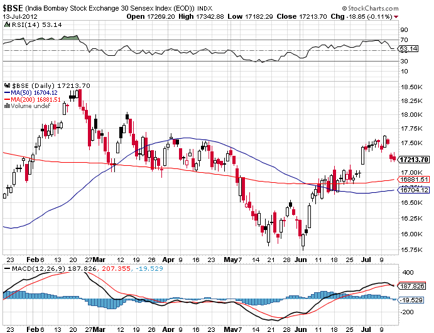 sharp upward rally from the 15,750 region that looks like a breakout. The rally saw a high of 17,650 and has since corrected sitting just above its 200 DMA 17,150. A breach of the 200 DMA will surely confirm a false breakout that could propel the index lower. On the other hand, the Sensex could continue to consolidate between the 200 DMA region and 17,650 for some more time before breaking out either way.
sharp upward rally from the 15,750 region that looks like a breakout. The rally saw a high of 17,650 and has since corrected sitting just above its 200 DMA 17,150. A breach of the 200 DMA will surely confirm a false breakout that could propel the index lower. On the other hand, the Sensex could continue to consolidate between the 200 DMA region and 17,650 for some more time before breaking out either way.
The probability of a breach of the 200 DMA is much higher than that of a breakout. Usually such things almost always resolve in favour of the major trend, which in the case of Sensex is down. Having said that, we are in the process of bottoming out in Indian equities and hence one needs to look out for buying opportunities without chasing rallies unnecessarily or out of a sense of panic.
NB: These notes are just personal musings on the world market trends as a sort of reminder to me on what I thought of them at a particular point in time. They are not predictions and none should rely on them for any investment decisions.
Sonali Ranade is a trader in the international markets






